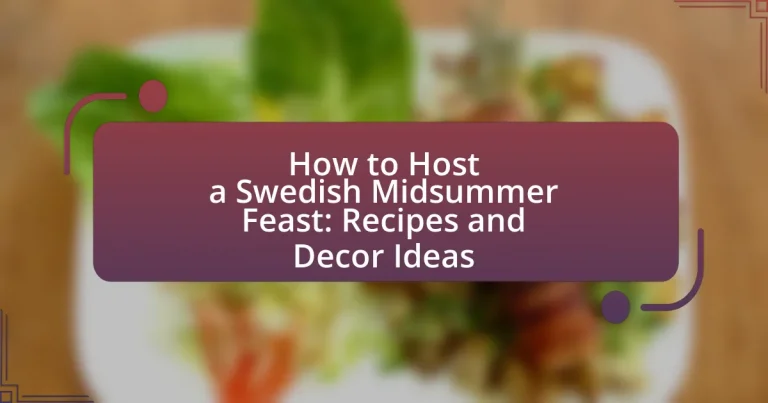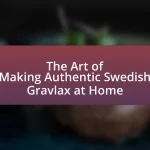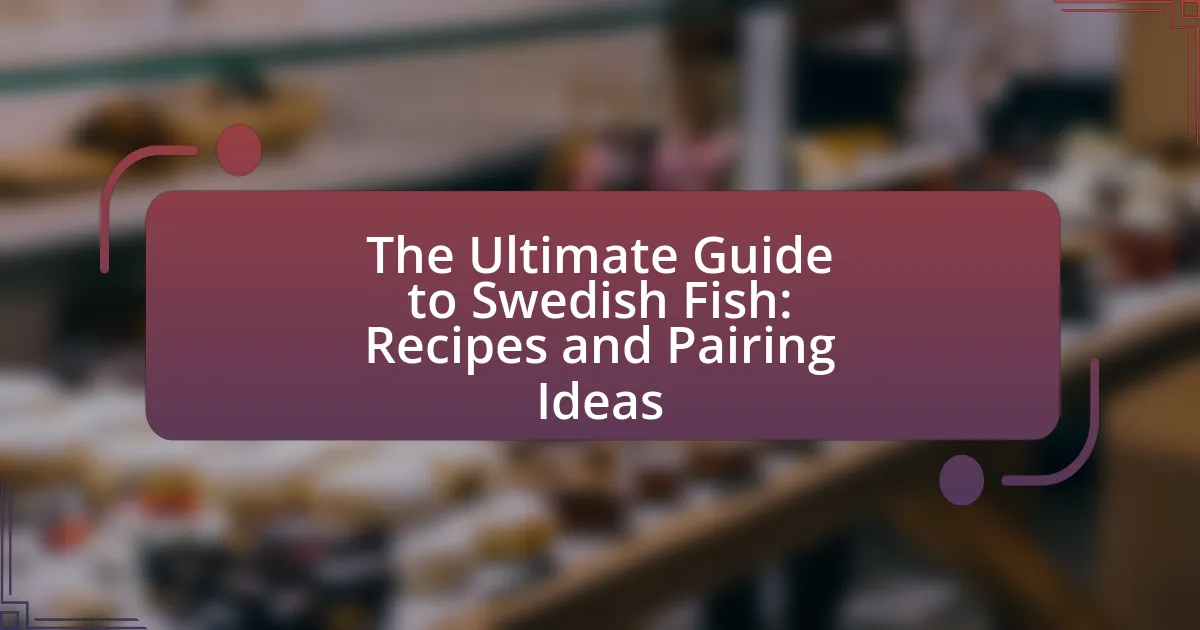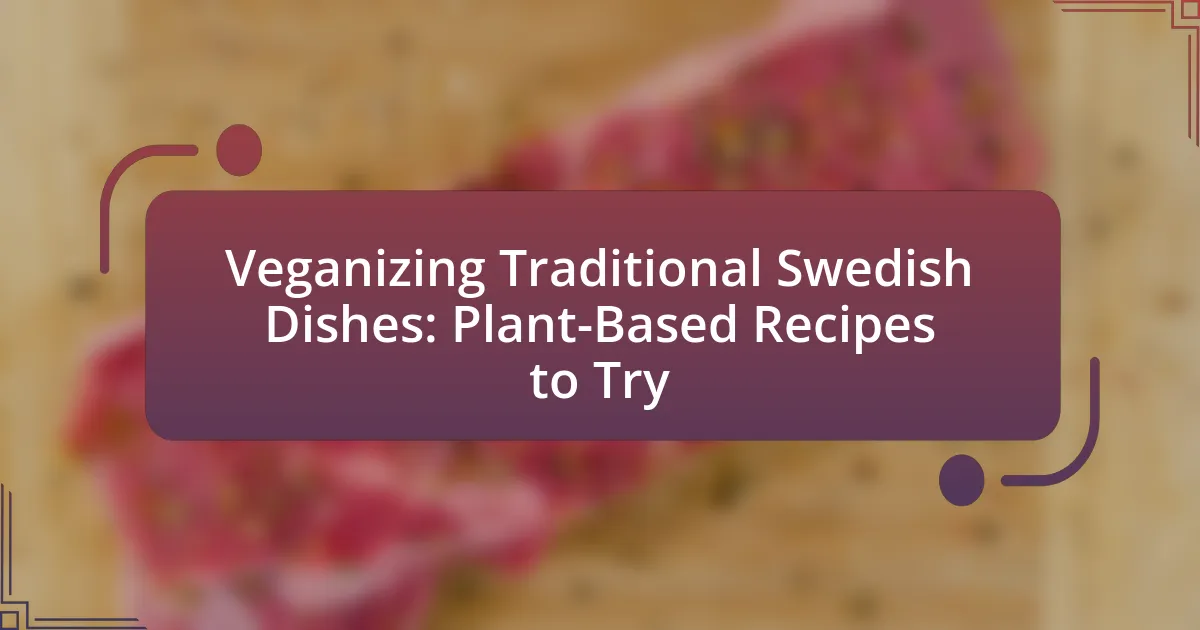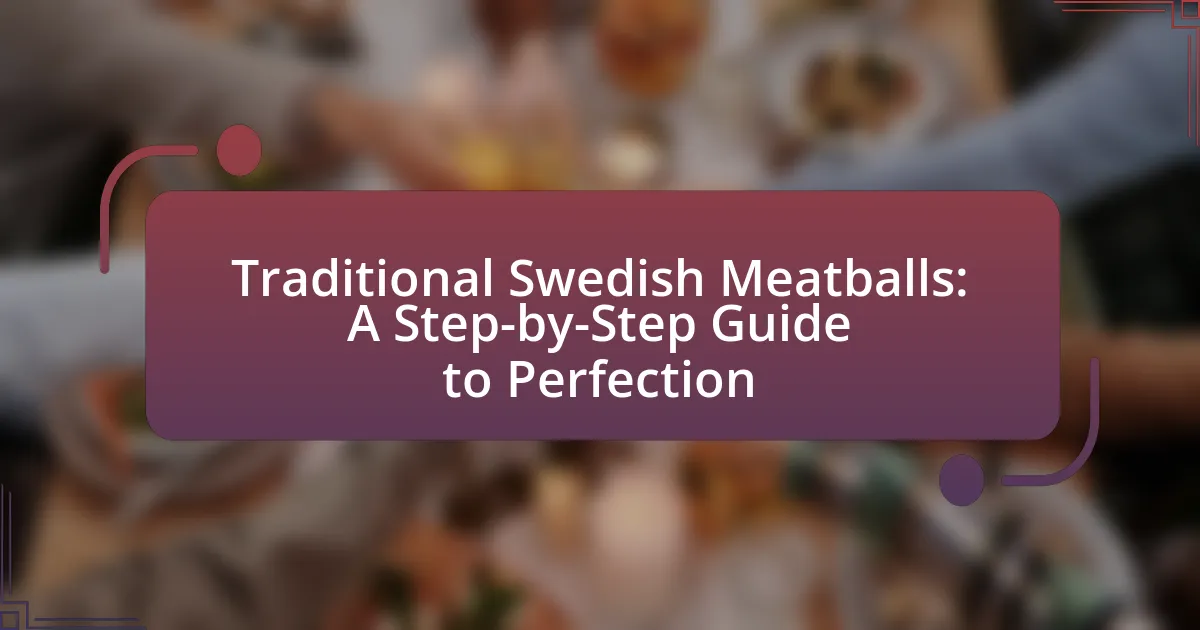A Swedish Midsummer Feast is a traditional celebration that marks the summer solstice, featuring a variety of dishes such as pickled herring, new potatoes, and strawberries. The event emphasizes community gathering, folk dances around a decorated maypole, and the incorporation of ancient agricultural practices. This article provides essential recipes, decoration ideas, and tips for hosting a successful Midsummer Feast, highlighting the cultural significance and traditional elements that define this cherished Swedish holiday. Key aspects include menu planning, dietary considerations, and creating an inviting atmosphere that reflects the spirit of Midsummer celebrations.
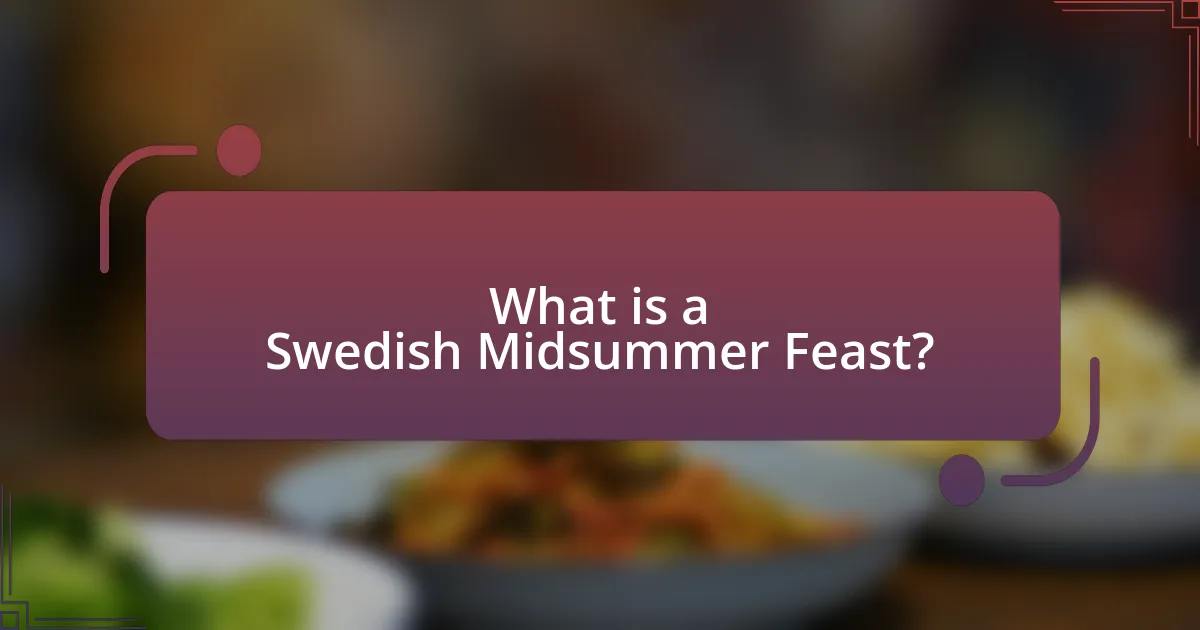
What is a Swedish Midsummer Feast?
A Swedish Midsummer Feast is a traditional celebration held in Sweden to mark the summer solstice, typically occurring in late June. This feast features a variety of dishes, including pickled herring, new potatoes, sour cream, and fresh dill, often accompanied by strawberries and cream for dessert. The event is characterized by the gathering of family and friends, the decoration of a maypole, and various folk dances, reflecting Sweden’s cultural heritage and connection to nature. The significance of the feast is rooted in ancient agricultural practices, celebrating the longest day of the year and the abundance of summer.
How is a Swedish Midsummer Feast traditionally celebrated?
A Swedish Midsummer Feast is traditionally celebrated by gathering family and friends to enjoy a meal outdoors, often featuring dishes like herring, new potatoes, and strawberries. The celebration typically includes the decoration of a maypole, which is adorned with flowers and greenery, and is central to the festivities. Participants engage in traditional songs and dances around the maypole, creating a festive atmosphere. This celebration aligns with the summer solstice, marking the longest day of the year, and has roots in ancient agricultural practices, emphasizing the importance of nature and community in Swedish culture.
What are the historical origins of Midsummer celebrations in Sweden?
Midsummer celebrations in Sweden have their historical origins in ancient pagan rituals that marked the summer solstice, a time when the sun reaches its highest point in the sky. These festivities were rooted in agricultural practices, celebrating fertility and the abundance of the earth, as well as honoring deities associated with nature and growth. The transition from pagan traditions to Christian influences occurred in the 14th century, leading to the incorporation of Christian elements into the celebrations, such as the feast of St. John the Baptist. This blend of pagan and Christian customs has shaped the modern Midsummer festival, which includes traditional activities like dancing around the maypole and feasting on seasonal foods.
What cultural significance does Midsummer hold in Swedish society?
Midsummer holds significant cultural importance in Swedish society as it marks the celebration of the summer solstice, symbolizing the longest day of the year and the arrival of summer. This festival is deeply rooted in Swedish traditions, where communities gather to celebrate with various customs such as dancing around the maypole, singing traditional songs, and enjoying seasonal foods like herring and new potatoes. Historically, Midsummer has been celebrated since pagan times, reflecting agricultural practices and the connection to nature, which remains a vital aspect of Swedish identity today. The event fosters community bonding and reinforces cultural heritage, making it one of the most cherished holidays in Sweden.
What are the key elements of a Swedish Midsummer Feast?
The key elements of a Swedish Midsummer Feast include traditional foods, floral decorations, and festive activities. Traditional foods typically consist of herring, new potatoes, sour cream, chives, and fresh strawberries, which reflect the seasonal produce available in Sweden during summer. Floral decorations often feature wildflowers, particularly the maypole, which is central to the celebration and is adorned with greenery and flowers. Festive activities include dancing around the maypole, singing traditional songs, and enjoying outdoor games, all of which enhance the communal and celebratory atmosphere of the feast. These elements collectively create a vibrant and culturally rich experience that is characteristic of Swedish Midsummer celebrations.
What types of food are typically served during a Midsummer Feast?
During a Midsummer Feast, traditional Swedish foods typically served include herring, new potatoes, sour cream, chives, and fresh strawberries. Herring is often prepared in various marinades, while new potatoes are boiled and served with butter. Sour cream and chives complement the potatoes, enhancing their flavor. Fresh strawberries, often enjoyed with cream, serve as a popular dessert. These foods reflect the seasonal availability of ingredients and cultural customs associated with Midsummer celebrations in Sweden.
How is the decor arranged for a traditional Midsummer celebration?
For a traditional Midsummer celebration, the decor is arranged with an emphasis on natural elements and vibrant colors. Commonly, people use flowers, particularly wildflowers, to create garlands and wreaths, which are often worn on the head or hung around the venue. Additionally, birch branches and greenery are used to adorn tables and create a festive atmosphere. The iconic maypole, decorated with flowers and ribbons, serves as a central decorative feature, symbolizing fertility and the arrival of summer. This arrangement reflects the celebration’s roots in nature and the importance of the summer solstice in Swedish culture.
What are the essential recipes for a Swedish Midsummer Feast?
The essential recipes for a Swedish Midsummer Feast include herring, new potatoes, sour cream, chives, meatballs, and strawberry cake. Herring is typically served in various marinades, such as mustard or onion, and is a traditional starter. New potatoes, boiled and often served with dill, complement the herring. Sour cream and chives are common accompaniments for the potatoes. Swedish meatballs, made from a mixture of ground beef and pork, are a staple dish. Finally, strawberry cake, featuring fresh strawberries and whipped cream, serves as a popular dessert, celebrating the summer harvest. These dishes reflect the seasonal ingredients and cultural traditions associated with Midsummer celebrations in Sweden.
How do you prepare traditional dishes like herring and new potatoes?
To prepare traditional dishes like herring and new potatoes, start by selecting high-quality pickled herring, which can be found in various flavors such as mustard or onion. Rinse the herring under cold water, then slice it into bite-sized pieces. Serve the herring on a platter with accompaniments like chopped red onions, sour cream, and fresh dill. For the new potatoes, choose small, waxy varieties, wash them thoroughly, and boil them in salted water until tender, typically around 15-20 minutes. Drain the potatoes, then toss them with butter and fresh dill before serving. This method reflects traditional Swedish practices, where herring and new potatoes are staples during Midsummer celebrations.
What desserts are popular during a Midsummer Feast?
Popular desserts during a Midsummer Feast include strawberries with cream, a traditional Swedish treat. This dessert is favored for its simplicity and seasonal freshness, as strawberries are typically in peak season during Midsummer in Sweden. Additionally, other popular options are elderflower cordial-flavored cakes and various types of pastries, which reflect the festive and floral themes of the celebration. These desserts are often enjoyed as part of the communal dining experience that characterizes Midsummer festivities.
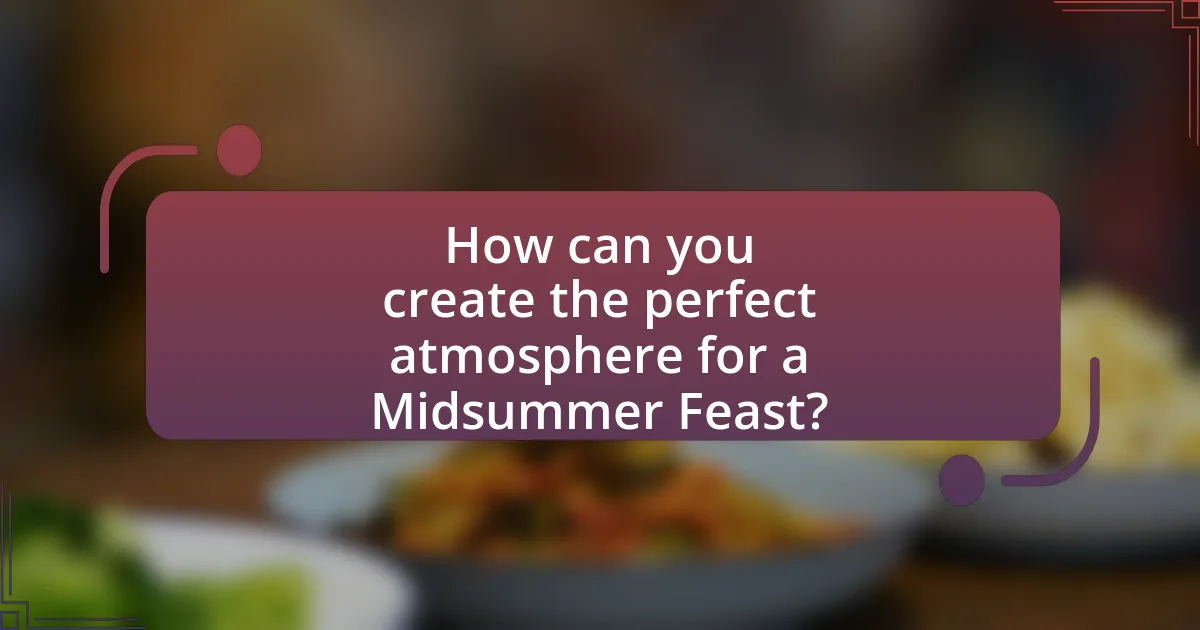
How can you create the perfect atmosphere for a Midsummer Feast?
To create the perfect atmosphere for a Midsummer Feast, focus on outdoor settings adorned with natural elements. Utilize flowers, particularly wildflowers and birch branches, to enhance the festive ambiance, as these are traditional symbols of Midsummer in Sweden. Incorporate colorful table settings with blue and yellow hues, reflecting the Swedish flag, to evoke national pride and celebration.
Lighting plays a crucial role; string lights or lanterns can create a warm, inviting glow as the sun sets, which is essential for evening gatherings. Additionally, traditional music, such as folk songs, can enhance the cultural experience, making the feast more immersive.
These elements collectively foster a joyful and vibrant atmosphere, aligning with the customs and spirit of the Midsummer celebration in Sweden.
What decorations are essential for a Swedish Midsummer celebration?
Essential decorations for a Swedish Midsummer celebration include flower garlands, maypoles, and wildflowers. Flower garlands are traditionally worn as crowns or hung around the venue, symbolizing nature and fertility. Maypoles, often adorned with greenery and flowers, serve as a central focal point for festivities, representing the arrival of summer. Wildflowers, gathered from the countryside, are used to decorate tables and spaces, enhancing the natural aesthetic of the celebration. These elements are rooted in Swedish cultural traditions, emphasizing the connection to nature during the summer solstice.
How can flowers and greenery enhance the decor?
Flowers and greenery enhance decor by adding vibrant colors, textures, and natural elements that create a lively atmosphere. Their presence can evoke feelings of freshness and joy, which are essential for celebrations like a Swedish Midsummer Feast. Research indicates that incorporating plants and flowers can improve mood and reduce stress, making the environment more inviting for guests. Additionally, specific floral arrangements can reflect the seasonal theme of Midsummer, aligning with traditional Swedish customs that celebrate nature and abundance.
What role do traditional symbols play in Midsummer decor?
Traditional symbols play a crucial role in Midsummer decor by embodying cultural significance and enhancing the festive atmosphere. These symbols, such as flowers, birch branches, and the maypole, represent fertility, renewal, and the celebration of summer solstice traditions in Sweden. For instance, the maypole, adorned with greenery and flowers, serves as a focal point for communal dancing and festivities, symbolizing the connection to nature and the joy of the season. Additionally, the use of wildflowers in decorations reflects the abundance of nature during this time, reinforcing the themes of growth and celebration inherent in Midsummer festivities.
How can you incorporate traditional music and activities into the feast?
To incorporate traditional music and activities into the feast, host live performances of folk music and organize traditional games. Folk music, such as the Swedish “låtar,” enhances the festive atmosphere and connects guests to cultural heritage. Activities like “midsommarstång” dancing and “kubb” (a traditional lawn game) engage participants and foster community spirit. Historical records indicate that these practices have been part of Swedish Midsummer celebrations for centuries, reinforcing their significance in creating an authentic experience.
What types of music are typically played during Midsummer celebrations?
Traditional Swedish folk music is typically played during Midsummer celebrations. This genre includes lively polkas, waltzes, and other folk dances that encourage participation and dancing among attendees. The music often features instruments such as fiddles, accordions, and flutes, which are integral to creating the festive atmosphere associated with Midsummer festivities in Sweden.
What traditional games and activities can be included for guests?
Traditional games and activities that can be included for guests at a Swedish Midsummer Feast are “kubb,” “midsummer pole dancing,” and “flower crown making.” Kubb, a lawn game originating from Sweden, involves throwing wooden sticks to knock over the opponent’s blocks, promoting teamwork and competition. Midsummer pole dancing, where guests dance around a decorated maypole, is a cultural tradition that symbolizes fertility and the arrival of summer. Flower crown making allows guests to create their own floral headpieces, a popular activity during Midsummer celebrations, enhancing the festive atmosphere. These activities not only engage guests but also celebrate Swedish heritage, making the feast more authentic and enjoyable.

What tips can help you successfully host a Swedish Midsummer Feast?
To successfully host a Swedish Midsummer Feast, focus on traditional elements such as food, decorations, and activities. Serve classic dishes like herring, new potatoes, and strawberries, which are staples of the feast. Decorate with fresh flowers and create a maypole, as these are central to the celebration. Incorporate traditional songs and dances to enhance the festive atmosphere. Historically, Midsummer is celebrated around the summer solstice, emphasizing the importance of nature and community, which should be reflected in your gathering.
How can you plan the menu effectively for your guests?
To plan the menu effectively for your guests at a Swedish Midsummer Feast, start by selecting traditional dishes that reflect the cultural significance of the celebration, such as herring, new potatoes, and strawberries. Incorporating seasonal ingredients is essential, as they enhance flavor and freshness; for instance, using locally sourced strawberries during the summer months ensures quality and supports local agriculture. Additionally, consider dietary restrictions and preferences of your guests by offering vegetarian or gluten-free options, which can be achieved by including dishes like a fresh salad or a vegetable platter. Research indicates that a well-balanced menu, featuring a variety of flavors and textures, enhances guest satisfaction and encourages social interaction, making the dining experience more enjoyable.
What considerations should you keep in mind for dietary restrictions?
When planning a Swedish Midsummer Feast, it is essential to consider dietary restrictions to ensure all guests can enjoy the meal. Key considerations include identifying common allergens such as gluten, dairy, nuts, and shellfish, as well as accommodating specific dietary preferences like vegetarian, vegan, or pescatarian diets. Research indicates that approximately 32 million Americans have food allergies, highlighting the importance of awareness in menu planning. Additionally, providing clear labeling of dishes can help guests make informed choices, thereby fostering an inclusive dining experience.
How can you ensure a smooth flow of the event?
To ensure a smooth flow of the event, create a detailed timeline that outlines each segment of the celebration, including setup, activities, and meal times. This structured approach allows for efficient coordination among participants and vendors, minimizing delays. For instance, a well-planned timeline can allocate specific time slots for traditional activities like maypole dancing and food serving, ensuring that guests remain engaged and the event progresses seamlessly. Additionally, having designated roles for helpers can facilitate transitions between activities, further enhancing the overall experience.
What are some common mistakes to avoid when hosting a Midsummer Feast?
Common mistakes to avoid when hosting a Midsummer Feast include inadequate planning, neglecting traditional elements, and underestimating guest needs. Inadequate planning can lead to insufficient food and drink, which is critical since Midsummer celebrations often involve large gatherings. Neglecting traditional elements, such as specific foods like herring and new potatoes, can diminish the authenticity of the feast. Underestimating guest needs, including seating and comfort, can result in an unwelcoming atmosphere, which is counterproductive to the festive spirit of Midsummer.
How can you prevent food preparation mishaps?
To prevent food preparation mishaps, ensure proper planning and organization before cooking. This includes reading recipes thoroughly, gathering all ingredients and tools in advance, and maintaining a clean workspace to minimize cross-contamination. Research indicates that organized kitchens reduce the likelihood of errors, as a study by the Journal of Culinary Science & Technology found that 70% of culinary mistakes stem from inadequate preparation.
What should you avoid in terms of decor and atmosphere?
Avoid overly cluttered or mismatched decor when hosting a Swedish Midsummer Feast. A chaotic atmosphere can detract from the celebratory spirit of the occasion, which traditionally emphasizes simplicity and natural beauty. For instance, using too many contrasting colors or styles can create visual disarray, making it difficult for guests to enjoy the ambiance. Instead, focus on cohesive themes that reflect Swedish traditions, such as floral arrangements with wildflowers and natural elements, which enhance the festive yet serene atmosphere typical of Midsummer celebrations.
